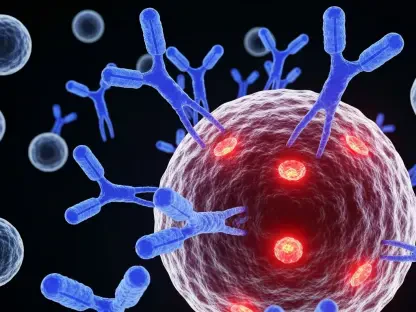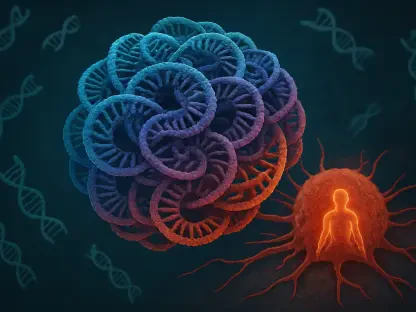In the relentless battle against the human immunodeficiency virus (HIV), a virus notorious for embedding itself permanently within the host’s genetic material, a series of groundbreaking scientific approaches offers new hope for more effective treatment and the potential for curing the virus. Upon infection, HIV integrates into the host cell’s DNA, presenting two primary outcomes: it may either actively reproduce, disseminating through the body, or lie dormant within a latent reservoir, posing persistent challenges to eradication. Despite the effectiveness of antiretroviral therapies (ART) in suppressing active viral replication, this latent reservoir remains unyielding to traditional treatments, requiring innovative scientific solutions to address the enduring presence of the virus in the body.
Scientific Exploration of HIV’s Latent Reservoir
Challenges in Treating HIV’s Persistent Latent Reservoir
For years, researchers like David Margolis at the University of North Carolina have tirelessly committed to investigating and dismantling the latent HIV reservoir, a significant barrier to complete virus eradication. The viral DNA embedded within the host’s genome allows for latent reservoirs that can activate at any given moment, even under ART. This issue mandates treatment strategies extending beyond typical lifetimes—potentially over 70 years—to achieve complete virus eradication. The persistence of these reservoirs means that no current treatment adequately eliminates the virus, thereby maintaining HIV’s stronghold in the host body.
A focus of Margolis’s research has been on latency-reversing agents (LRAs) that aim to ‘wake up’ these dormant cells, thus making them detectable and targetable by immune responses. Despite successful activation of latent cells during clinical trials, a notable reduction in the viral reservoir itself is often unachieved when using LRAs alone. The subtle complexity of HIV’s integration into host DNA suggests the need for a multi-faceted approach that combines LRAs with other complementary treatments to confront and mitigate the virus effectively.
Broadly Neutralizing Antibodies as a Game-Changing Strategy
Amid this scientific landscape, an innovative avenue has gained traction: the use of broadly neutralizing antibodies (bNAbs), designed to neutralize diverse strains of HIV and flag infected cells for immune system targeting. This approach mirrors advancements in oncology where antibodies have been increasingly used to identify and combat cancer cells, demonstrating potential transformative effects. Dr. Jesper Gunst of Aarhus University has been a pivotal figure in research coupling bNAbs with LRAs, yielding enhanced virus suppression outcomes.
By employing bNAbs early in treatment, alongside standard ART measures, studies have reflected more rapid viral reservoir decay and sustained suppression without continuous ART. Such antibody-based strategies have shown potential not only in cases of initial infection but also in supporting individuals to maintain control of the virus without ongoing medication. These promising results encourage continued exploration, pointing toward the broader potential roles of bNAbs in both treatment and prevention paradigms.
Broadening Horizons: Prevention and Long-Term Control
Exploring Preventive Applications of bNAbs
The quest to harness the full capacity of broadly neutralizing antibodies also extends into preventative medicine. Research into using bNAbs as a form of prophylaxis is gaining momentum, particularly concerning mother-to-child transmission during breastfeeding. Despite ART regimens during pregnancy, many postpartum women struggle to maintain medication adherence due to the demands of newborn care, presenting a gap where HIV could be transmitted to the infant.
At the forefront of prevention is the PedMAb trial, which examines the use of bNAbs, such as VRC07-523LS and CAP256V2LS, to provide immediate immune coverage to newborns. Remarkably, the trial has reported zero instances of infection in infants breastfed by HIV-positive mothers, despite the inherent risks present. Although faced with regulatory challenges restricting specific antibody use in certain locations, the team remains unwavering in their dedication to this promising preventive avenue, pursuing antibody variations unrestricted by current policies.
Overcoming Logistical and Political Challenges
Conducting international trials, especially involving complex biologics like bNAbs, introduces logistical, regulatory, and political challenges. The restrictions set by organizations such as the U.S. NIH on deploying certain bNAbs in regions like South Africa underscore hurdles researchers face. Despite these challenges, scientists are actively seeking collaborative networks and developing alternative bNAbs, ensuring progress continues unabated. The drive to sculpt a future where preventative bNAbs safeguard vulnerable populations against HIV infection reflects an inspiring commitment to impactful, real-world solutions.
Innovative Strategies: Navigating Toward an HIV Cure
Combination Therapies and Their Impact
As the scientific community delves deeper into understanding and utilizing bNAbs, the consensus highlights their revolutionary potential in managing and potentially curing HIV. Combining latency-reversal agents and bNAbs offers a promising framework for future treatment paradigms, seeking not only to manage the virus but also to dismantle durable barriers that have long vied for dominance in this ongoing combat. The additive effect of these therapies suggests a pathway where even durable suppression of viral activity can be achieved without lifelong ART.
Further research into personalized medicine approaches, considering individual patients’ viral profiles and the sensitivity of their viral envelope sequences to specific antibodies, holds promise for refined treatment protocols. Ultimately, this could lead to tailored interventions maximizing each patient’s potential for achieving long-term viral suppression, presenting a vision where HIV ceases to be an irreversible diagnosis, but rather a manageable condition.
Leveraging Collaborative Efforts for a Unified Goal
The advances in bNAb strategies underscore the nuanced nature of this scientific endeavor, showcasing how coordinated, global research initiatives can transcend traditional healthcare hurdles. Collaborative efforts among universities, healthcare institutions, and regulatory bodies hold the key to overcoming existing barriers and facilitating widespread access to next-gen HIV treatments. Establishing partnerships with organizations across various geographies enhances these endeavors, fostering environments where innovative solutions can be swiftly translated into clinical applications.
While establishing protocols integrating bNAbs remains in early stages, continued investment and international commitment to research and development are crucial. By highlighting success stories and encouraging a culture of innovation, the future of HIV healthcare could well embody approaches that not only eradicate the virus but prevent transmission, ultimately leading to an HIV-free generation.
Envisioning an HIV-Free Future
Conducting international clinical trials, particularly those involving intricate biologics like broadly neutralizing antibodies (bNAbs), presents a web of logistical, regulatory, and political obstacles. These challenges become more pronounced when considering the restrictions imposed by organizations like the U.S. National Institutes of Health (NIH), which limit the deployment of certain bNAbs in countries such as South Africa. These regulations highlight the significant hurdles that researchers must navigate when attempting to bring innovative treatments to global populations. Nonetheless, in the face of these obstacles, dedicated scientists are actively forging collaborative networks across countries, striving to create pathways that overcome these barriers. They are also engaged in the development of alternative bNAbs, ensuring that progress is not stalled. This relentless pursuit underscores a profound commitment to shaping a future where preventative bNAbs can effectively protect vulnerable populations against HIV infection. It reflects a commitment to tangible, real-world solutions, offering hope and potential for those most at risk. The drive for innovation in this field isn’t just about science; it’s about combining expertise and resources to bring about meaningful change in global health practices.









